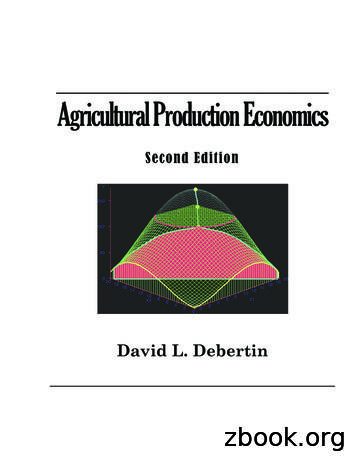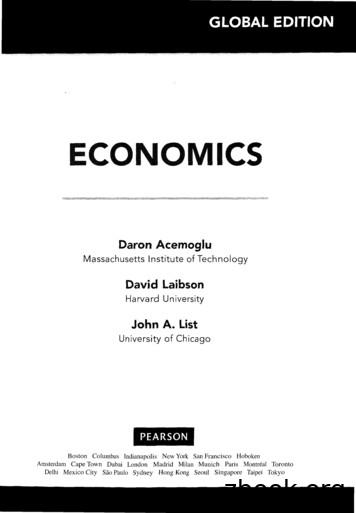Agricultural Production Economics
Agricultural Production EconomicsSecond EditionDavid L. Debertin
Agricultural Production EconomicsSecond EditionAgricultural Production Economics (Second Edition, Amazon Createspace 2012) is a revised edition of theTextbook Agricultural Production Economics published by Macmillan in 1986 (ISBN 0-02-328060-3). This is afree pdf download of the entire book. As the author, I own the copyright. Amazon markets bound print copiesof the book at amazon.com at a nominal price for classroom use. The book can also be ordered through collegebookstores using the following ISBN numbers:ISBN-13 978-1469960647ISBN-10 1469960648The format and coverage remains similar to the first edition, many small revisions and updates have been made.All graphs have been redrawn using the latest in computer imaging technology. The book contains acomprehensive treatment of the traditional agricultural production economics topics employing both detailedgraphics and differential calculus. The text focuses on the neoclassical factor-product, factor-factor and productproduct models, and is suitable for an advanced undergraduate or a beginning graduate-level course in staticproduction economics. Chapters also deal with linear programming, risk and uncertainty and intertemporalresource allocation. A basic knowledge of differential calculus is assumed. Individual chapters are largely selfcontained, and the book is suitable for instruction at a variety of levels depending on the specific needs of theinstructor and the mathematics background of the students.This is one of three agricultural economics textbooks by David L. Debertin. A companion 100-page color bookAgricultural Production Economics (The Art of Production Theory) is also a free download. A bound print copyis also available on amazon.com at a nominal cost under the following ISBN numbers:ISBN- 13: 978-1470129262ISBN- 10: 1470129264The third book is aimed at upper-division undergraduate students of microeconomics in agricultural economicsand economics. It is a 242-page book titled Applied Microeconomics (Consumption, Production and Markets)and is a free download. Bound print copies are also available at amazon.com and through college bookstores ata nominal cost under the following ISBN numbers:ISBN‐13: 978‐1475244342ISBN-10: 1475244347This book Applied Microeconomics is much newer than Agricultural Production Economics, having beencompleted in 2012. As the author, I would suggest downloading and studying this Applied Microeconomicsbook before diving into Agricultural Production Economics. This book uses spreadsheets to calculate numbersand draw graphs. Many of the examples and numbers are the same ones used in Agricultural ProductionEconomics, so the two books are tied to each other.
If you have difficulty accessing or downloading any of these books, or have other questions, contact me atthe email address, below.David L. DebertinProfessor EmeritusUniversity of KentuckyDepartment of Agricultural EconomicsLexington, Kentucky, 40515-0276ddeberti@uky.edu
David L. Debertin is Professor Emeritus of Agricultural Economics at the University of Kentucky, Lexington,Kentucky and has been on the University of Kentucky Agricultural Economics faculty since 1974 with aspecialization in agricultural production and community resource economics. He received a B.S. and an M.S.degree from North Dakota State University, and completed a Ph.D. in Agricultural Economics at PurdueUniversity in 1973. He has taught the introductory graduate-level course in agricultural production economicsin each year he has been at the University of Kentucky. The first edition of Agricultural Production economicswas published in hardback by Macmillan in 1986. He began work on the second edition of the book after theMacmillan edition went out of print in 1992, taking advantage of emerging two-and three-dimensionalcomputer graphics technologies by linking these to the calculus of the modern theory of production economics.The book has been edited and revised each year since 1992. All diagrams and figures benefit from improvedcomputer technology since the first edition was written. The current edition also includes two chapters oncontemporary production theory that were not part of the first edition.
AgriculturalProductionEconomicsSECOND EDITIONDAVID L. DEBERTIN
Agricultural Production EconomicsSECOND EDITIONDavid L. DebertinUniversity of Kentucky
First edition 1986 Macmillan Publishing Company, a division of Macmillan IncPearson EducationCorporate Editorial OfficesOne Lake StreetUpper Saddle River, N.J. USA 07458(First edition copyright returned to author, 1992)Second edition 2012 David L. DebertinDavid L. DebertinUniversity of Kentucky,Department of Agricultural Economics400 C.E.B. Bldg.Lexington, KY 40546-0276All rights reserved. No part of this book may be reproduced or transmitted in any form or byany means, without permission from the author.Library of Congress Cataloging in Publication DataFirst edition (1986)Debertin, David L.Agricultural Production EconomicsBibliography:p1. Agricultural production economics2. Agriculture–Economic aspects–Econometric models1. Title.HD1433.D43 1986338.1'072485-13918ISBN 0-02-328060-3Second edition (2012)Debertin, David L.Agricultural Production EconomicsBibliography:p1. Agricultural production economics2. Agriculture–Economic aspects–Econometric modelsISBN-13 978-1469960647ISBN-10 1469960648To Tanya, Kyle and Tamara
Preface (Second Edition)Agricultural Production Economics (Second Edition) is a revised edition of the TextbookAgricultural Production Economics published by Macmillan in 1986 (ISBN 0-02-328060-3).Although the format and coverage remains similar to the first edition, many small revisionsand updates have been made. All graphs have been redrawn using the latest in computerimaging technology.The book contains a comprehensive treatment of the traditional agricultural productioneconomics topics employing both detailed graphics and differential calculus. The text focuseson the neoclassical factor-product, factor-factor and product-product models, and is suitablefor an advanced undergraduate or a beginning graduate-level course in static productioneconomics. Chapters also deal with linear programming, risk and uncertainty andintertemporal resource allocation. Two new chapters have been added dealing withcontemporary production theory in the factor and product markets. A basic knowledge ofdifferential calculus is assumed. Individual chapters are largely self-contained, and the bookis suitable for instruction at a variety of levels depending on the specific needs of the instructorand the mathematics background of the students.David L. DebertinUniversity of KentuckyDepartment of Agricultural Economics400 C.E.B. Bldg.Lexington, KY, 40546-0276ddeberti@uky.edu
Agricultural Production EconomicsSECOND EDITIONTable of ContentsChapter 1. Introduction . 11.1 Economics Defined. 21.2 The Logic of Economic Theory. 21.3 Economic Theory as Abstraction. 31.4 Economic Theory Versus Economic Model. 31.5 Representing Economic Relationships . 41.6 Consumption Versus Production Economics . 41.7 Microeconomics Versus Macroeconomics. 51.8 Statics Versus Dynamics . 61.9 Economics Versus Agricultural Economics . 71.10 Agricultural Production Economics . 71.11 The Assumptions of Pure Competition. 81.12 Why Retain the Purely Competitive Model. 101.13 Concluding Comments . 10Questions for Thought and Class Discussion . 12References. 12Chapter 2. Production With One Variable Input. 132.1 What Is a Production Function . 142.2 Fixed Versus Variable Inputs and the Length of Run . 172.3 The Law of Diminishing Returns . 192.4 Marginal and Average Physical Product . 212.5 MPP and the Marginal Product Function . 222.6 A Neoclassical Production Function . 262.7 MPP and APP for the Neoclassical Function . 282.8 Sign, Slope and Curvature . 292.9 A Single-Input Production Elasticity. 332.10 Elasticities of Production for a Neoclassical Production Function. 352.11 Further Topics on the Elasticity of Production. 362.12 Concluding Comments . 37Problems and Exercises . 37Chapter 3. Profit Maximization with One Input and One Output . 393.1 Total Physical Product Versus Total Value of the Product . 403.2 Total Factor or Resource Cost . 413.3 Value of the Marginal Product and Marginal Factor Cost. 413.4 Equating VMP and MFC . 433.5 Calculating the Exact Level of Input Use to Maximize Output or Profits . 453.6 General Conditions for Profit Maximization . 513.7 Necessary and Sufficient Conditions. 523.8 The Three Stages of the Neoclassical Production Functiom . 523.9 Further Topics on States of Production . 563.10 The Imputed Value of an Additional Unit of an Input . 56i
3.11 Concluding Comments.59Problems and Exercises.59Chapter 4. Costs, Returns and Profits on the Output Side .614.1 Some Basic Definitions.624.2 Simple Profit Maximization from the Output Side .684.3 The Duality of Cost and Production.714.4 The Inverse of a Production Function .744.5 Linkages between Cost and Production Functions .764.6 The Supply Function for the Firm.774.7 Concluding Comments.79Problems and Exercises.79Chapter 5. Production with Two Inputs .815.1 Introduction .825.2 An Isoquant and the Marginal Rate of Substitution .865.3 Isoquants and Ridge Lines .935.4 MRS and the Marginal Product.955.5 Partial and Total Derivatives and the Marginal Rate of Substitution.975.6 Concluding Comments.99Notes .100Problems and Exercises.100Chapter 6. Maximization in the Two-Input Case .1026.1 Introduction to Maximization.1036.2 The Maximum of a Function.1046.3 Some Illustrative Examples.1056.4 Some Matrix Algebra Principles .1106.5 A Further Illustration.1116.6 Maximizing a Profit Function with Two Inputs.1126.7 A Comparison with Output- or Yield-Maximization Criteria.1156.8 Concluding Comments.116Notes .117Problems and Exercises.117Chapter 7. Maximization Subject to Budget Constraints .1187.1 Introduction .1197.2 The Budget Constraint .1197.3 The Budget Constraint and the Isoquant Map.1217.4 Isoclines and the Expansion Path .1237.5 General Expansion Path Conditions.1247.6 The Production Function for the Bundle.1267.7 Pseudo-Scale Lines .1287.8 Summary of Marginal Conditions and Concluding Comments .131Problems and Exercises.134Chapter 8. Further Topics in Constrained Maximization and Minimization.1358.1 Simple Mathematics of Global Profit Maximization .1368.2 Constrained Revue Maximization.138ii
8.38.48.58.68.78.88.9Second Order Conditions. 142Interpretation of the Lagrangean Multiplier . 143Constrained Output Maximization . 145Cost-Minimization Subject to a Revenue Constraint . 147Application in the Design of a Lease. 1488.7.1 Cash Rent . 1488.7.2 Shared Rental Arrangements. 149An Application to an Acreage Allotment Problem. 151Concluding Comments . 154Problems and Exercises . 155Reference . 156Chapter 9. Returns to Scale, Homogeneous Functions, and Euler’s Theorem. 1579.1 Economies and Diseconomies of Size . 1589.2 Economies and Diseconomies of Scale . 1599.3 Homogeneous Production Functions. 1619.4 Returns to Scale and Individual Production Elasticities. 1629.5 Duality of Production and Cost for the Input Bundle. 1649.6 Euler’s Theorem . 1679.7 Concluding Comments . 168Problems and Exercises . 169Chapter 10. The Cobb-Douglas Production Function . 17110.1 Introduction. 17210.2 The Original Cobb-Douglas Function . 17210.3 Early Generalizations. 17310.4 Some Characteristics of the Cobb-Douglas Type of Function . 17410.5 Isoquants for the Cobb-Douglas Type of Function . 17510.6 The Production Surface for the Cobb-Douglas Production Function. 17710.7 Profit Maximization with the Cobb-Douglas Production Function. 18010.8 Duality and the Cobb-Douglas Production Function. 18110.9 Constrained Output or Revenue Maximization . 18410.10 Concluding Comments . 185Problems and Exercises . 185Reference . 186Chapter 11. Other Agricultural Production Functions . 18711.1 Introduction. 18811.2 The Spillman.
Agricultural Production Economics Second Edition Agricultural Production Economics (Second Edition, Amazon Createspace 2012) is a revised edition of the Textbook Agricultural Production Economics published by Macmillan in 1986 (ISBN 0-02-328060-3). This is a free pdf downloa
Marketing; Agricultural Finance. Courses Taught: Farm Financial Management Introduction to Agricultural Economics Associate Professor (52% research, 48% teaching) July 1995 to June 2002 Department of Agricultural Economics, Mississippi State University Specialty Areas: Production Economics; Livestock Production and
The following At-A-Glance charts present comparative admission, cost, curricula and other relevant information about the state universities. . Agricultural Communications Agricultural Economics Agricultural Industries Agricultural Mechanization Agricultural Occupational Education Agricultural Production Agricultural Science Agronomy, Field Crops
Std. 12th Economics Smart Notes, Commerce and Arts (MH Board) Author: Target Publications Subject: Economics Keywords: economics notes class 12, 12th commerce, 12th economics book , 12th commerce books, class 12 economics book, maharashtra state board books for 12th, smart notes, 12th std economics book , 12th economics book maharashtra board, 12th economics guide , maharashtra hsc board .
International Finance 14. Development Policy 15. Institutional Economics 16. Financial Markets 17. Managerial Economics. 13 18. Political Economy 19. Industrial Economics 20. Transport Economics 21. Health Economics 22. Experimental and Behavioral Economics 23. Urban Economics 24. Regional Economics 25. Poverty and Income Distribution
conventional economics.11ll2ll3ll4l Agricultural economists have made substantial contributions to research in economics, econometrics, development economics. and environmental economics. Agricultural economics influences food policy, agricultural policy, and environmental policy. I Contents [hide] 1 Origins 2 Development
Slope of a linear curve 13 Slope of a nonlinear curve 13 1 What is Agricultural economics? Agricultural economics is an applied social science that deals with how producers, consumers, and societies use scarce resources in the production, marketing, and consumption of food and fiber products. In agricultural markets, the forces of supply
ECONOMICS 40 Chapter 1: The Principles and Practica of Economics 40 1.1 The Scope of Economics 41 Economic Agents and Economic Resources 41 Definition of Economics 42 Positive Economics and Normative Economics 43 Microeconomics and Macroeconomics 44 1.2 Three Principles of Economics
7. What is the name of this sequence of events which results in the production of a protein? 8. What is Reverse Transcription? 9. When does Reverse Transcription occur? 10. How can Reverse Transcription be used in Biotechnology? DESIGNER GENES: PRACTICE –MOLECULAR-GENETIC GENETICS 2 CENTRAL DOGMA OF MOLECULAR GENETICS 1. Where is DNA housed in Eukaryotic Cells? most is stored in the nucleus .























